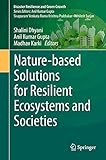Nature-based solutions for resilient ecosystems and societies [electronic resource] / Shalini Dhyani, Anil Kumar Gupta, Madhav Karki, editors.
Material type: TextSeries: Disaster resilience and green growthPublication details: Singapore : Springer, 2020.Description: 1 online resourceContent type:
TextSeries: Disaster resilience and green growthPublication details: Singapore : Springer, 2020.Description: 1 online resourceContent type: - text
- computer
- online resource
- 9789811547126
- 9811547122
- 338.9/27 23
- HC79.E5
| Item type | Current library | Shelving location | Call number | Status | Date due | Barcode | Item holds | |
|---|---|---|---|---|---|---|---|---|
 Electronic Book
Electronic Book
|
Kuakarun Nursing Library | Processing unit | Online Access | eb36045 |
Intro -- Foreword by the IUCN President -- From the Desk of the Chair IUCN-CEM -- Acknowledgments -- Contents -- Editors and Contributors -- Abbreviations -- Chapter 1: Opportunities and Advances to Mainstream Nature-Based Solutions in Disaster Risk Management and Climate Strategy -- 1.1 Introduction -- 1.2 Nature-Based Solutions (NbS) -- 1.3 Global Recognition and Acceptance of NbS -- 1.4 Progress and Developments in NbS on the Science Front -- 1.4.1 Restoration of Degraded Landscapes and Natural Forests for Increasing Ecosystems Resilience
1.4.2 NbS to Manage Heat Islands and Flood Risks in Urban Areas -- 1.4.3 Slope Stabilisation and Reducing Landslide Risks -- 1.5 Structure of the Book -- References -- Part I: Decision Making Tools for Mainstreaming NbS -- Chapter 2: Scaling up Spring Revival in the Himalaya: Graduating from Spring-Centric to Aquifer-Centric Nature-Based Solutions -- 2.1 Introduction -- 2.1.1 Himalayas and Climate Change -- 2.1.2 A Paradigm Shift in Perspective -- 2.1.3 Present State of Knowledge -- 2.2 Objectives and Research Questions -- 2.3 Methods -- 2.3.1 Study Area -- 2.3.2 Landscape-Level Experiments
2.3.3 Environmental Isotope Study -- 2.3.4 Landscape-Level Groundwater Recharge Experiment -- 2.4 Results -- 2.4.1 Environment Isotope Study -- 2.4.2 Landscape-Level Groundwater Recharge -- 2.5 Discussions -- 2.5.1 Aquifers Characteristics and Inequity in Groundwater Storage -- 2.5.2 Mountain Aquifers Super-Sensitive to Precipitation Patterns -- 2.5.3 Visualizing the Aquifers Systems -- 2.5.4 Recharge Implications -- 2.6 Conclusions -- References -- Chapter 3: Ecosystem-Based Integrated and Participatory Watershed Management -- 3.1 Introduction -- 3.2 Literature Review
3.3 Ecosystem-Based Watershed Management Approach -- 3.4 Importance of Ecosystem Approach to Watershed Management -- 3.4.1 A Case Study: Shivapuri Nagarjun National Park (SNNP) Watershed, Nepal -- 3.4.1.1 Brief Description of the SNNP Watershed -- 3.5 Ecosystem Services Provided by the Watershed -- 3.5.1 Provisioning Services (MA 2005) -- 3.5.2 Regulating Services -- 3.5.3 Cultural Services -- 3.5.4 Habitat Services -- 3.6 Key EAWM Strategies Adopted -- 3.7 Inclusive Approaches -- 3.8 Implementation of Ecosystem-Based Integrated Watershed Management Programs
3.8.1 Promotion of Green Environment through Mobilization of Local Participation -- 3.8.2 Enhancing Farmer�s Capacity on Ecosystem-Based Integrated Watershed Management -- 3.8.3 Participatory Stakeholder Interactions -- 3.8.4 Environment and People-Centered Conservation Measures for Maintaining Land Productivity -- 3.8.5 Degraded Land Rehabilitation -- 3.9 Conclusion and Lessons Learned -- References -- Chapter 4: Nature-Based Solution for Balancing the Food, Energy, and Environment Trilemma: Lessons from Indonesia -- 4.1 Introduction -- 4.2 Methods -- 4.2.1 Study Sites -- 4.2.2 Data Collection
Over the past few decades, the frequency and severity of natural and human-induced disasters have increased across Asia. These disasters lead to substantial loss of life, livelihoods and community assets, which not only threatens the pace of socio-economic development, but also undo hard-earned gains. Extreme events and disasters such as floods, droughts, heat, fire, cyclones and tidal surges are known to be exacerbated by environmental changes including climate change, land-use changes and natural resource degradation. Increasing climate variability and multi-dimensional vulnerabilities have severely affected the social, ecological and economic capacities of the people in the region who are, economically speaking, those with the least capacity to adapt. Climatic and other environmental hazards and anthropogenic risks, coupled with weak and wavering capacities, severely impact the ecosystems and Natures Contributions to People (NCP) and, thereby, to human well-being. Long-term resilience building through disaster risk reduction and integrated adaptive climate planning, therefore, has become a key priority for scientists and policymakers alike. Nature-based Solutions (NbS) is a cost-effective approach that utilizes ecosystem and biodiversity services for disaster risk reduction and climate change adaptation, while also providing a range of co-benefits like sustainable livelihoods and food, water and energy security. This book discusses the concept of Nature-based Solutions (NbS) - both as a science and as art - and elaborates on how it can be applied to develop healthy and resilient ecosystems locally, nationally, regionally and globally. The book covers illustrative methods and tools adopted for applying NbS in different countries. The authors discuss NbS applications and challenges, research trends and future insights that have wider regional and global relevance. The aspects covered include: landscape restoration, ecosystem-based adaptation, ecosystem-based disaster risk reduction, ecological restoration, ecosystem-based protected areas management, green infrastructure development, nature-friendly infrastructure development in various ecosystem types, agro-climatic zones and watersheds. The book offers insights into understanding the sustainable development goals (SDGs) at the grass roots level and can help indigenous and local communities harness ecosystem services to help achieve them. It offers a unique, essential resource for researchers, students, corporations, administrators and policymakers working in the fields of the environment, geography, development, policy planning, the natural sciences, life sciences, agriculture, health, climate change and disaster studies.
Added to collection customer.56279.3
There are no comments on this title.

